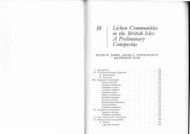You also want an ePaper? Increase the reach of your titles
YUMPU automatically turns print PDFs into web optimized ePapers that Google loves.
Bryoria Brodo & D.Hawksw.<br />
(Key includes Pseudephebe)<br />
Introduction<br />
The separation <strong>of</strong> the genus Bryoria from<br />
Alectoria is by the brown and gray beard lichen<br />
characteristic. These commonly produce richly<br />
branched to loose filamentous pendent thallus,<br />
rarely growing short, erect bushy or ray-like, the<br />
thallus more or less adapted to the substrate.<br />
Like the true beard lichens <strong>of</strong> the genus Usnea,<br />
they are in most cases attached to the substrate<br />
only at one place with a short base. In contrast to<br />
Usnea the filamentous thallus does not have a<br />
tough central strand and does not produce Usnic<br />
acid. Propagation is, as a rule, by soredia, which<br />
are produced in rounded, projecting to split-form<br />
soralia, rarely also taken over by isidia. In most<br />
species apothecia are only very rarely produced.<br />
The greatest number <strong>of</strong> the species live<br />
epiphytically on conifer and deciduous trees,<br />
especially on thinned sites; many <strong>of</strong> these lichens<br />
may however also commonly cross over to<br />
silicate rocks. The remaining are inhabitants on<br />
silicate rock; among the indigenous species on B.<br />
chalybeiformis is numbered in this group. The<br />
Bryoria species lay claim to the region<br />
mountainous sites with high precipitation; in low<br />
precipitation regions their occurrence is limited<br />
to humid cool valleys. B. fuscescens exclusively<br />
shows a relatively broad ecological amplitude<br />
and is also to be found in low precipitation<br />
regions even in open habitats. B. bicolor and B.<br />
smithii live on very humid, oceanic influenced<br />
habitats. The epiphytic species avoid<br />
eutrophication. The Bryoria species are<br />
declining. B. fuscescens and B. capillaris are to<br />
a high degree endangered, several are threatened<br />
with extinction.<br />
B. capillaris, b. fuscescens, B. implexa and B.<br />
nadvornikiana are distributed in the boreal<br />
conifer zone and corresponding sites in central<br />
Europe and penetrate into the mountain forests <strong>of</strong><br />
the mediterranean region. B. fremnotii is also a<br />
dweller <strong>of</strong> the boreal conifer zone, however it is<br />
already extremely rare in central Europe. The<br />
area <strong>of</strong> the two oceanic species B. bicolor and<br />
B. smithii reaches from central or southern<br />
Scandinavia over western Europe into the mild,<br />
high precipitation region (especially in the<br />
mountains) <strong>of</strong> central Europe. They are (almost)<br />
entirely lacking in the mediterranean region. B.<br />
chalybeiformis has an arctic-alpine distribution.<br />
Of ca. 45 species occurring predominantly in<br />
the cold and cool regions <strong>of</strong> the earth, ca. 9 are in<br />
Germany and ca. 8 have been proven. B.<br />
subcana is one difficult species not proven from<br />
the region.<br />
Genus Characteristics and Determination<br />
Thallus bushy, richly branching, usually beardlike<br />
pendent, rarely erect to decumbent, <strong>of</strong><br />
filamentous, ± rounded stems, smooth segments,<br />
beige, gray, brown, or black, sometimes with<br />
short branches, frequently with split-form or<br />
warty soralia, with or without psuedocyphellia.<br />
Thallus segments radially symmetrical, with a<br />
cortex <strong>of</strong> periclinal elongate hyphae, medulla<br />
almost always loosely structured. Photobiont<br />
Trebouxia-like. Ap. lateral, rare, with permanent<br />
to soon disappearing thalloid margin. Asci<br />
clavate, thick-walled, Lecanora type. Sp. 1celled,<br />
ellipsoidal. Ch: <strong>of</strong>ten with Atranorin,<br />
Fumarprotocetraric acid, rarely Alectorialic acid,<br />
Psoromic acid, or Norstictic acid.<br />
1 Thallus (medulla) KC+ red, C+ red/C- (reaction<br />
<strong>of</strong>ten very rapidly fleeting; do not add too much<br />
C after K!), K+ yellow or K-. With (<strong>of</strong>ten<br />
indefinite and sparse) pseudocyph. With<br />
Alectorialic acid and ± Barbatolic acid or<br />
Gyrophoric acid . 2<br />
1* Thallus KC-, C-. Without Alectorialic acid,<br />
Barbatolic acid, or Gyrophoric acid . 4<br />
2 Thallus P- (only soralia usually P+ red), K- or<br />
K+ yellowish. Thallus brown to brown- black,<br />
similarly variable like b. fuscescens, sometimes<br />
with short branches and twisting limbs. Limbs<br />
very fragile. Pseudocyph. usually definite,<br />
fusiform, whitish to brownish, <strong>of</strong>ten twisting<br />
around the branches. Branching dichotomously,<br />
branching angle rather obtuse. With Gyrophoric<br />
acid, ± Fumarprotocetraric acid, ± Atranorin (B.<br />
vrangiana”) . B. implexa<br />
2* Thallus P+ intensively yellow, K+ remaining<br />
intensively yellow, soralia P+ orange-red.<br />
Pseudocyph. usually sparse and indefinite.<br />
Alectorialic acid. Fumarprotocetraric acid in the<br />
soralia . 3<br />
3 With ± right angle oriented rigid (“thorny”),<br />
basal somewhat constricted short branches.<br />
Basal thallus segment usually blackish. Thallus<br />
otherwise pale brown, pale olive-brown, pale<br />
gray-greenish, rarely dark brown, <strong>of</strong>ten with rose<br />
or violet tones, in the lower parts isotomicdichotomous<br />
branching, toward the tip more<br />
112





